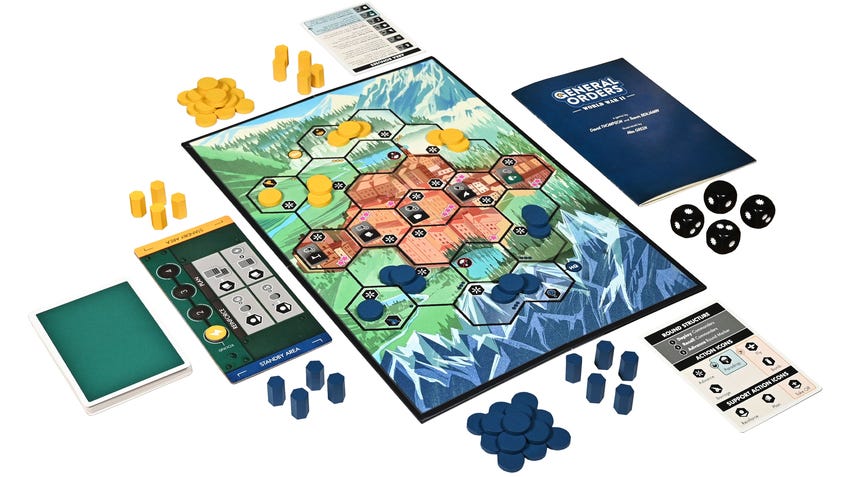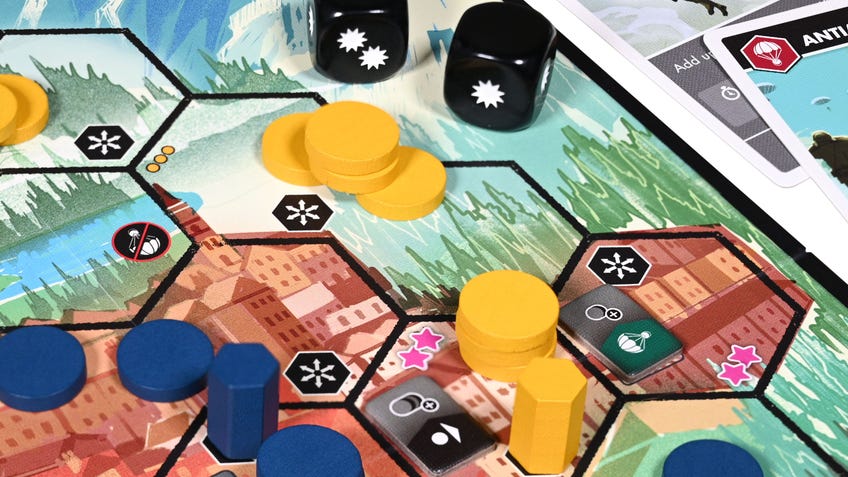Undaunted designers’ pint-sized wargame General Orders pulls the perfect lunchtime battle from its tiny box
It’s bigger on the inside.
It’s no exaggeration to say that everytime I see General Orders: World War II, I’m still taken aback by just how darn small it is.
The latest game from David Thompson and Trevor Benjamin - creators of the exceptionally accomplished Undaunted series - is a marvel of minimalism, condensing a strategic duel of commanding troops, planning tactics and holding objective points into a half-hour experience that fits into a seriously small box. Three Magic: The Gathering deck boxes, two-and-a-bit Coke cans, two paperbacks; however you measure it, it’s a tiny footprint.
Simply being small doesn’t guarantee a good game, of course. Yet General Orders’ size isn’t the only surprising thing about it. What it manages to pull out of such a small package is a richly strategic two-player game that punches well above its weight given the extremely modest time and effort it asks of you. Honestly, this feels about as close as board games get to pulling off a magic trick.
Like Undaunted, General Orders sees Thompson and Benjamin melding together the traditional dice-chucking battles and back-and-forth scrapping to hold ground of classic wargames with the modern sensibility and polish of another genre. Where Undaunted took the deckbuilding cardplay of Dominion and its ilk as its added ingredient, General Orders turns to the worker-placement gameplay popularised by the likes of Agricola and even D&D spin-off Lords of Waterdeep.
Honestly, this feels about as close as board games get to pulling off a magic trick.
Each of General Orders’ four rounds blitzes by in just a couple of minutes, as players take turns to perform one action. These actions are designated by popping one of your commander pieces on a free space either on the game’s dinky main board or its even smaller side board, respectively reflecting more direct commands to your troops to push into new areas, barrage the enemy or paradrop into a hex or more support-like moves to reinforce your troops (by adding extra discs to controlled spaces) or draw cards from a stack of one-off abilities.
The breezy nature of the actions gives way to tactical thinking without wasting minutes spent planning every move. It helps that the actions themselves are made as lean as possible, too. Barraging - to bombard a space up to three hexes away from your artillery - is a single die roll that removes the resulting number of unit discs from the targeted space. Brutally efficient.

Even battles, triggered when the two players’ discs jostle for space, are beautifully trim; the defending player rolls a single die to similarly bring down their attackers’ numbers, before discs are removed simultaneously until one colour remains. It’s wonderfully concise, and recalls the ruthlessly to-the-point battle resolution of classic wargames such as the original Civilization; biggest number wins, with the added spice of that dice roll to throw in the odd chance for a sudden reversal.
In the same way, spending one of your precious commanders to draw cards rather than pushing forward on the map can be costly, but worth it. The operations cards offer powerful effects that can bolster attacking strength with extra dice, allow for additional move actions and bring more of your troops onto the field, often making the difference between a win or loss. On top of the dice rolls, it means there’s a fair amount of room for luck to prevail, without completely overriding the advantage given by tactical thinking and picking your moments.
With only four rounds, there’s little time for discussion or frustration when things don’t go your way. General Orders favours the aggressive approach, rewarding those who push forward towards their opponent’s HQ and fight for every inch of ground. Victory comes down to claiming the opposing headquarters (leading to an instant win) or holding the most valuable ground at the end of four rounds, resulting in a tug-of-war over the hexes worth victory points. Holding those points also grants bonus effects to your actions, further increasing their value. Expect them to change hands a lot.

As the advance action space of hexes on the map can only be used if you don’t already have troops present - otherwise discs can only be added using the separate reinforce action, available to each player once a turn, or by using your limited paradrop action - the game naturally creates a realistic challenge of keeping areas supplied while under attack, without requiring complex rules or simulation. The game as a whole cleverly abstracts the minutiae of war - its units and references to real-life combatants are kept vague for the most part - without scrimping on offering players meaningful decisions to mull over or ways to respond to their opponent’s moves.
Adding to the generous offering is the fact that General Orders is almost two games in one. Its double-sided board flips from the alpine mountains of Northern Italy, with control hexes running across a central row and units needing to deal with the difficulty of navigating terrain, to a more open island in the Pacific. That second map introduces aerial combat with dedicated rules for taking off planes, controlling regions via air and bombing ground forces, as well as mixing up the operations cards, layout of objective areas and other abilities available to both players. With a literal flip of the board, it presents a notably different way to play - somehow squeezing what feels like a complete expansion into this already well-stocked box.
General Orders squeezes what feels like a complete expansion into this already well-stocked box.
General Orders doesn’t reinvent the wheel when it comes to wargames or worker-placement games - there are more complex and ambitious titles out there that will keep those invested in either genre satisfied in the longer-term. What it does with aplomb is offer an incredibly polished, impeccably presented meeting of the two in a form that makes for the perfect snack between those full-course buffets. That's hard to resist, especially when it asks so little in return.
What Thompson and Benjamin pull off in a £20 game that takes under half an hour to play - even with teaching newcomers, by my own experience - is simply outstanding. General Orders neatly fills the gap it aims at, and then some. It’s an ingenious distillation of the dramatic upsets and surprises of dice-driven combat games into a tiny box, which serves as the ideal thing to break out over lunchtime, in the pub or while you wait for your next epic campaign. At its very best, it feels like magic.

